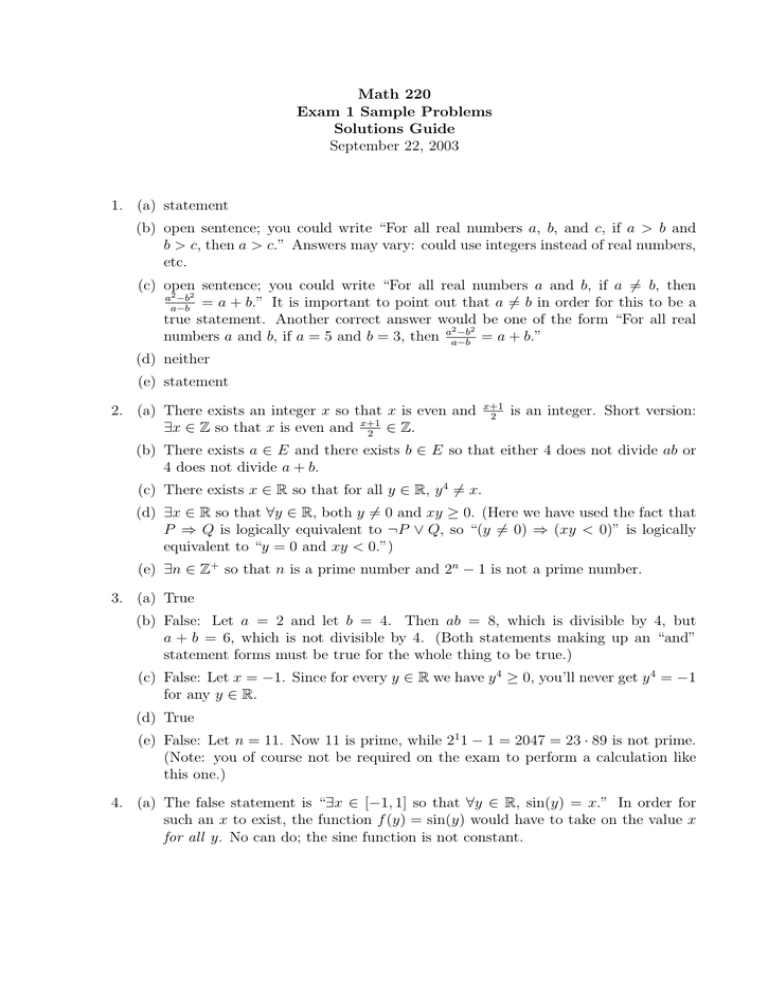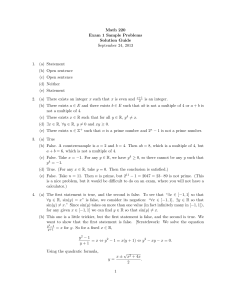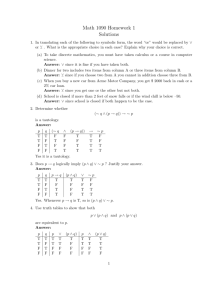Math 220 Exam 1 Sample Problems Solutions Guide September 22, 2003
advertisement

Math 220 Exam 1 Sample Problems Solutions Guide September 22, 2003 1. (a) statement (b) open sentence; you could write “For all real numbers a, b, and c, if a > b and b > c, then a > c.” Answers may vary: could use integers instead of real numbers, etc. (c) open sentence; you could write “For all real numbers a and b, if a 6= b, then a2 −b2 = a + b.” It is important to point out that a 6= b in order for this to be a a−b true statement. Another correct answer would be one of the form “For all real 2 −b2 numbers a and b, if a = 5 and b = 3, then aa−b = a + b.” (d) neither (e) statement 2. (a) There exists an integer x so that x is even and ∃x ∈ Z so that x is even and x+1 ∈ Z. 2 x+1 2 is an integer. Short version: (b) There exists a ∈ E and there exists b ∈ E so that either 4 does not divide ab or 4 does not divide a + b. (c) There exists x ∈ R so that for all y ∈ R, y 4 6= x. (d) ∃x ∈ R so that ∀y ∈ R, both y 6= 0 and xy ≥ 0. (Here we have used the fact that P ⇒ Q is logically equivalent to ¬P ∨ Q, so “(y 6= 0) ⇒ (xy < 0)” is logically equivalent to “y = 0 and xy < 0.”) (e) ∃n ∈ Z+ so that n is a prime number and 2n − 1 is not a prime number. 3. (a) True (b) False: Let a = 2 and let b = 4. Then ab = 8, which is divisible by 4, but a + b = 6, which is not divisible by 4. (Both statements making up an “and” statement forms must be true for the whole thing to be true.) (c) False: Let x = −1. Since for every y ∈ R we have y 4 ≥ 0, you’ll never get y 4 = −1 for any y ∈ R. (d) True (e) False: Let n = 11. Now 11 is prime, while 21 1 − 1 = 2047 = 23 · 89 is not prime. (Note: you of course not be required on the exam to perform a calculation like this one.) 4. (a) The false statement is “∃x ∈ [−1, 1] so that ∀y ∈ R, sin(y) = x.” In order for such an x to exist, the function f (y) = sin(y) would have to take on the value x for all y. No can do; the sine function is not constant. (b) The false statement is “∀x ∈ R, ∃y ∈ R so that As long as y 6= −1, we have y2 − 1 = y − 1, y+1 If y = −1, then y 2 −1 y+1 y 2 −1 y+1 = x.” Indeed, let x = −2. y 6= −1. is undefined. Thus to find a y ∈ R so that can only look for y 6= −1, in which case y 2 −1 y+1 y 2 −1 y+1 = −2, we = y − 1 = −2 if y = −1. So the only value of y that could possibly work is y = −1, but unfortunately, defined when y = −1. Thus no value of y will work. y 2 −1 y+1 is not 5. (a) (¬P ∨ Q) ∨ (P ∧ ¬Q) (b) (P ∨ ¬Q) ∧ (Q ∧ ¬P ) 6. (a) P T T T T F F F F Q T T F F T T F F R P ∨ Q ¬Q ∨ ¬R (P ∨ Q) ∧ (¬Q ∨ ¬R) T T F F F T T T T T T T F T T T T T F F F T T T T F T F F F T F It is not necessary to include the fourth and fifth columns, but it helps in understanding the last column. (b) Here it might be helpful, though not necessary, to use the fact that P ⇒ Q is logically equivalent to ¬P ∨ Q. P Q P ∧ ¬Q T T T F F T F F F T F F P ⇒Q (P ∧ ¬Q) ∨ (P ⇒ Q) (= ¬P ∨ Q) T T F T T T T T Since the last column is all True, we see that (P ∧ ¬Q) ∨ (¬P ∨ Q) is a tautology . (c) First of all, we have P Q R P ∧ Q ¬P ∨ R T T T T F F F F T T F F T T F F T F T F T F T F T T F F F F F F T F T F T T T T R ⇒ ¬Q (P ∧ Q) ∧ (¬P (= ¬R ∨ ¬Q) F T T T F T T T ∨ R) ∧ (R ⇒ ¬Q) F F F F F F F F It’s worth pointing out in passing (though not required by the directions of the problem) that the right-most statement form is a contradiction. In any case, we find P Q R (P ∧ Q) ∧ (¬P ∨ R) ∧ (R ⇒ ¬Q) ⇒ R T T T T T T T F T T F T T T F F T F T T F T F T T F F T T F F F Thus the given statement form is a tautology . 7. Throughout these problems we use several times the following logical equivalences: ¬(P ∧ Q) ⇔ ¬P ∨ ¬Q, ¬(P ∨ Q) ⇔ ¬P ∧ ¬Q, P ∧ (Q ∨ R) ⇔ (P ∧ Q) ∨ (P ∧ R), P ∨ (Q ∧ R) ⇔ (P ∨ Q) ∧ (P ∨ R), P ⇒ Q ⇔ ¬P ∨ Q. (a) ¬((P ∧ Q) ∨ (P ∧ ¬R)) ⇔ (¬(P ∧ Q) ∧ ¬(P ∧ ¬R)) ⇔ (¬P ∨ ¬Q) ∧ (¬P ∨ R) ⇔ ¬P ∨ (¬Q ∧ R) . (b) Q ∧ (P ∨ ¬Q) ⇔ (Q ∧ P ) ∨ (Q ∧ ¬Q) ⇔ Q∧P . The last equality comes from the fact that Q ∧ ¬Q is always false. (c) ¬(∃x so that (P (x) ∧ ¬Q(x)) ∨ (P (x) ∧ R(x))) ⇔ ∀x, ¬((P (x) ∧ ¬Q(x)) ∨ (P (x) ∧ R(x))) ⇔ ∀x, ¬P (x) ∨ (Q(x) ∧ ¬R(x)) . The last step is a modification of part (a). (d) ¬(∀x, ∃y so that P (x, y) ∨ ¬R(x, y)) ∨ (∃x so that ∀y, ¬P (x, y) ∧ Q(x, y)) ⇔ (∃x so that ∀y, ¬P (x, y) ∧ R(x, y)) ∨ (∃x so that ∀y, ¬P (x, y) ∧ Q(x, y)) ⇔ ∃x so that ∀y, ¬P (x, y) ∨ (¬R(x, y) ∧ Q(x, y)) . (e) (P ⇒ Q) ∧ (R ∨ Q) ⇔ (¬P ∨ Q) ∧ (R ∨ Q) ⇔ (¬P ∧ R) ∨ Q . (f) From problem 6(c), we see that this statement form is a tautology. Thus it is equivalent to any tautology we choose, say R ∨ ¬R . 8. The blanks should be in order as follows: a ∈ Z; b ∈ Z; c ∈ Z; a | c; an integer; c is b c ; b an integer; integer; a | c. 9. The blanks should be in order as follows: x ∈ R+ ; x < n1 ; n2 ; n1 ; n2 ; 1 ; x 1 ; n2 1 ; x 1 < n x < n.





